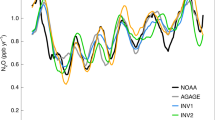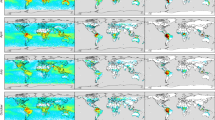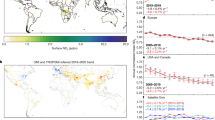Abstract
Emissions from fossil fuel combustion and biomass burning reduce local air quality and affect global tropospheric chemistry. Nitrogen oxides are emitted by all combustion processes and play a key part in the photochemically induced catalytic production of ozone, which results in summer smog and has increased levels of tropospheric ozone globally1. Release of nitrogen oxide also results in nitric acid deposition, and—at least locally—increases radiative forcing effects due to the absorption of downward propagating visible light2. Nitrogen oxide concentrations in many industrialized countries are expected to decrease3, but rapid economic development has the potential to increase significantly the emissions of nitrogen oxides4,5,6,7 in parts of Asia. Here we present the tropospheric column amounts of nitrogen dioxide retrieved from two satellite instruments GOME8,9 and SCIAMACHY10 over the years 1996–2004. We find substantial reductions in nitrogen dioxide concentrations over some areas of Europe and the USA, but a highly significant increase of about 50 per cent—with an accelerating trend in annual growth rate—over the industrial areas of China, more than recent bottom-up inventories suggest6.
This is a preview of subscription content, access via your institution
Access options
Subscribe to this journal
Receive 51 print issues and online access
$199.00 per year
only $3.90 per issue
Buy this article
- Purchase on Springer Link
- Instant access to full article PDF
Prices may be subject to local taxes which are calculated during checkout




Similar content being viewed by others
References
Volz, A. & Kley, D. Evaluation of the Montsouris series of ozone measurements made in the nineteenth century. Nature 332, 240–242 (1988)
Solomon, S. et al. On the role of nitrogen dioxide in the absorption of solar radiation. J. Geophys. Res. 104 (D10), 12047–12058 (1999)
Lövblad, G., Tarrasón, L., Tørseth, K. & Dutchak, S. (eds) EMEP Assessment Part I. European Perspective The Cooperative Programme for Monitoring and Evaluation of the Long-range Transmission of Air Pollutants in Europe, October 2004 48–51 (Norwegian Meteorological Institute, Oslo, 2004)
van Aardenne, J. A., Carmichael, G. R., Levy, H. II, Streets, D. & Hordijk, L. Anthropogenic NOx emissions in Asia in the period 1990–2002. Atmos. Environ. 33, 633–646 (1999)
Streets, D. G. & Waldhoff, S. T. Present and future emissions of air pollutants in China: SO2, NOx, and CO. Atmos. Environ. 34, 363–374 (2000)
Streets, D. G. et al. An inventory of gaseous and primary aerosol emissions in Asia in the year 2000. J. Geophys. Res. 108 (D21), 8809, doi:10.1029/2002JD003093 (2003)
Akimoto, H. Global air quality and pollution. Science 302, 1716–1719 (2003)
Burrows, J. P. et al. The Global Ozone Monitoring Experiment (GOME): Mission concept and first scientific results. J. Atmos. Sci. 56, 151–175 (1999)
European Space Agency, GOME Global Ozone Measuring Experiment Users Manual (ESA SP-1182, ESA/ESTEC, Noordwijk, 1995)
Bovensmann, H. et al. SCIAMACHY—Mission objectives and measurement modes. J. Atmos. Sci. 56, 127–150 (1999)
Leue, C., Wenig, M., Wagner, T., Platt, U. & Jähne, B. Quantitative analysis of NOx emissions from GOME satellite image sequences. J. Geophys. Res. 106, 5493–5505 (2001)
Richter, A. & Burrows, J. P. Retrieval of tropospheric NO2 from GOME measurements. Adv. Space Res. 29, 1673–1683 (2002)
Martin, R. V. et al. An improved retrieval of tropospheric nitrogen dioxide from GOME. J. Geophys. Res. 107, 4437–4456 (2002)
Petritoli, A. et al. First comparison between ground-based and satellite-borne measurements of tropospheric nitrogen dioxide in the Po basin. J. Geophys. Res. 109, D15307, doi:10.1029/2004JD004547 (2004)
Beirle, S., Platt, U., Wenig, M. & Wagner, T. Weekly cycle of NO2 by GOME measurements: a signature of anthropogenic sources. Atmos. Chem. Phys. 3, 2225–2232 (2003)
Kunhikrishnan, T. et al. Analysis of tropospheric NOx over Asia using the model of atmospheric transport and chemistry (MATCH-MPIC) and GOME-satellite observations. Atmos. Environ. 38, 581–596 (2004)
Martin, R. V. et al. Global inventory of nitrogen oxide emissions constrained by space-based observations of NO2 columns. J. Geophys. Res. 108, 4537–4548 (2003)
Richter, A. et al. Satellite measurements of NO2 from international shipping emissions. Geophys. Res. Lett. 31, doi:10.1029/2004GL020822 (2004)
Boersma, K. F., Eskes, H. J. & Brinksma, E. J. Error analysis for tropospheric NO2 retrieval from space. J. Geophys. Res. 109, doi:10.1029/2003JD003962 (2004)
Jaeglé, L., Steinberger, L., Martin, R. V. & Chance, K. Global partitioning of NOx sources using satellite observations: Relative roles of fossil fuel combustion, biomass burning and soil emissions. Faraday Discuss. 130, 407–423, doi:10.1039/b502128f (2005)
Massie, S. T., Torres, O. & Smith, S. J. Total Ozone Mapping Spectrometer (TOMS) observations of increases in Asian aerosol in winter from 1979 to 2000. J. Geophys. Res. 109, D18211, doi:10.1029/2004JD004620 (2004)
Horowitz, L. W. et al. A global simulation of tropospheric ozone and related tracers: description and evaluation of MOZART, version 2. J. Geophys. Res. 108 (D24), 4474, doi:10.1029/2002JD002853 (2003)
Olivier, J. et al. Present and Future Surface Emissions of Atmospheric Compounds. POET (Precursors of Ozone and their Effects in the Troposphere) Report no. 2, 4–12 (EU project EVK2-1999-00011, 2003).
Martin, R. V., Jacob, D. J., Yantosca, R. M., Chin, M. & Ginoux, P. Global and regional decreases in tropospheric oxidants from photochemical effects of aerosols. J. Geophys. Res. 108 (D3), 4097, doi:10.1029/2002JD002622 (2003)
Zhao, J. & Gallagher, K. S. Clean vehicle development in China. Sinosphere J. 6, 20, http://www.chinaenvironment.net/sino/sino14.pdf (2003)
Chipperfield, M. P. Multiannual simulations with a three-dimensional chemical transport model. J. Geophys. Res. 104, 1781–1805 (1999)
Koelemeijer, R. B. A., Stammes, P., Hovenier, J. W. & de Haan, J. F. A fast method for retrieval of cloud parameters using oxygen A band measurements from the Global Ozone Monitoring Experiment. J. Geophys. Res. 106, 3475–3490 (2001)
Rozanov, V., Diebel, D., Spurr, R. J. D. & Burrows, J. P. GOMETRAN: a radiative transfer model for the satellite project GOME—the plane parallel version. J. Geophys. Res. 102, 16683–16695 (1997)
Koelemeijer, R. B. A., de Haan, J. F. & Stammes, P. A database of spectral surface reflectivity in the range 335–772 nm derived from 5.5 years of GOME observations. J. Geophys. Res. 108 (D2), 4070, doi:10.1029/2002JD002429 (2003)
Acknowledgements
GOME and SCIAMACHY lv0 and lv1 spectra were provided by ESA through DFD/DLR. We thank M. Chipperfield for providing SLIMCAT data. This study has been funded in part by the research programmes of the University of Bremen, the Max Planck Society, the European Union, German Aerospace (DLR), the German Ministry of Science and Education (BMBF) and the European Space Agency (ESA).
Author information
Authors and Affiliations
Corresponding author
Ethics declarations
Competing interests
Reprints and permissions information is available at npg.nature.com/reprintsandpermissions. The authors declare no competing financial interests.
Supplementary information
Supplementary Discussion
The file contains additional discussion of error sources in the NO2 retrieval and their effect on the conclusions of the paper. It is a summary of the replies given to the reviewer's questions and comments on this topic. (DOC 39 kb)
Rights and permissions
About this article
Cite this article
Richter, A., Burrows, J., Nüß, H. et al. Increase in tropospheric nitrogen dioxide over China observed from space. Nature 437, 129–132 (2005). https://doi.org/10.1038/nature04092
Received:
Accepted:
Issue Date:
DOI: https://doi.org/10.1038/nature04092
This article is cited by
-
Activity Improvement of Mn/Al2O3 for NH3-SCR Reaction via the Rare-Earth (Ce, La, Nd and Y) Oxides Modification
Catalysis Letters (2024)
-
Estimate of near-surface NO2 concentrations in Fenwei Plain, China, based on TROPOMI data and random forest model
Environmental Monitoring and Assessment (2023)
-
Effects of shared governance and cost redistribution on air pollution control: a study of game theory–based cooperation
Environmental Science and Pollution Research (2023)
-
Simultaneous remote sensing of multiple atmospheric gases (CO2, CH4, and H2O) based on an all-fiber laser heterodyne spectroradiometer
Applied Physics B (2023)
-
Spatiotemporal variations of ozone exposure and its risks to vegetation and human health in Cyprus: an analysis across a gradient of altitudes
Journal of Forestry Research (2023)
Comments
By submitting a comment you agree to abide by our Terms and Community Guidelines. If you find something abusive or that does not comply with our terms or guidelines please flag it as inappropriate.



